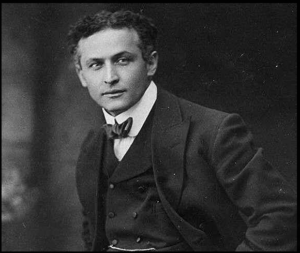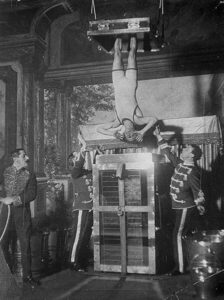 He was well-known as a magician and escape artist, but it wasn’t until Harry Houdini appeared in Cumberland that he became a superstar.
He was well-known as a magician and escape artist, but it wasn’t until Harry Houdini appeared in Cumberland that he became a superstar.
In Houdini: The Key by Patrick Culliton, he wrote, “Opening the show last night, Houdini referred to Cumberland as marking an important epoch in his life and said that if he ever wrote an autobiography of his life, he would devote a chapter to his experiences in Cumberland inaugurating a new phase of his career as a public entertainer.”
Houdini was a vaudeville star, which meant that although he was a headline entertainer, he appeared on stage as part of a roster of acts. His time on stage was never more than half an hour. Some professional magicians had moved up from vaudeville to touring with their own shows, but Houdini was at the top of his game in vaudeville.
“But Vaudeville was the mass entertainment of its time, and not only was Houdini at one point the highest paid performer in American Vaudeville, but he dominated the circuits and the cities in which he played,” according to the Wild About Harry blog. “It could be said that part of Houdini’s all-eclipsing fame had to do with the fact that he appeared on more stages and in more cities more often than any other major magician of that time.
He could have remained in vaudeville and remained the big fish in a slowly shrinking pond for years to come. However, he wasn’t someone to rest on his laurels. He was always pushing himself to get better at his craft.
In 1925, Houdini decided that it was time to have a show that was entirely his own. He teamed up with L. Lawrence Weber, a well-known theatrical manager, and the pair met daily to plan what Houdini promised would “be the most novel and gorgeous entertainment of its kind ever seen,” according to advanced publicity for the show.
He commissioned original music for the show and hired what eventually totaled eight assistants. His wife, Bess, made the costumes. When boxed up, the show filled 50 crates and a 60-foot-long railroad car.
“Houdini was hands on with every detail which included all the tour and travel, the theatre’s and the technical aspects, accommodations, promotional material and all designing decisions,” according Dean Carnegie in his Magic Detective blog. “This was another major move for Houdini in his performing career and every detail was planned fully and how everything was to be executed was very important to this great legend.”
The show arrived in Cumberland to perform at the Maryland Theatre at 37 N. Mechanic Street on August 31, 1925. The theater first opened on November 21, 1907, and sat 1,800 people.
“Some of the magicians thought I was going to use a lot of women in my forthcoming show and they are trying to beat me to it,” Houdini said of his show. “They have been misinformed. I am going to specialize in Houdini stuff.”
And that “Houdini stuff” was above average magic, amazing illusions, death-defying escapes, and the debunking of spiritualists and mediums.
He performed at the theater from August 31 to September 2. His final day also included a special matinee tailored to delight children.
“In many ways it was the culmination and a celebration of his entire career,” according to the Wild About Harry blog.
Houdini’s famous 3 Shows in One debuts in Cumberland
 When Harry Houdini decided to take his career to the next level, he did it in Cumberland at the Maryland Theatre. He debuted what was known as his “3 Shows In One” on August 31, 1925.
When Harry Houdini decided to take his career to the next level, he did it in Cumberland at the Maryland Theatre. He debuted what was known as his “3 Shows In One” on August 31, 1925.
The Cumberland Evening Times printed the program for the 2.5-hour show (with two 10-minute intermissions).
Houdini entered the stage to Pomp and Circumstance, and the stage curtain was a gigantic tapestry made up of ribbons and awards that Houdini had been presented during his career.
The first show or act featured Houdini performing a series of magic tricks, both original and well-known.
“To prove there was nothing up his sleeves, Houdini would ‘tear’ off the arm sleeves of his tuxedo and perform with bare arms,” according to the Wild About Harry Blog.
The highlight trick was called “Paligenesia Or Taking a Living Man to Pieces and Restoring Him by Installment,” according to the Evening Times. Apparently, Houdini performed the trick using a cockney accent reminiscent of Dr. Lynn, who invented the trick.
During the second show, Houdini performing the “Feats That Have Made Him Famous!” or escapes. This included tricks called Metamorphosis, the East Indian Needle Mystery, and the Water Torture Cell. The latter trick involved Houdini locked in a straitjacket and being placed head down in a tank of water with his ankles clamped and locked from which he had to escape before running out of air.
The Evening Times noted, “A 1,000 reward will be made to anyone proving that it is possible to obtain air in the upside down position in which Houdini releases himself from this water filled torture cell.”
The third show featured Houdini exposing the different methods fake spiritualists and mediums used to fool people. Having been trained as a medium early in his career, Houdini knew how the frauds were perpetrated.
The “3 Shows In One” was a hit. Houdini’s partner in producing the show, L. Lawrence Weber sent a note to Houdini, which read, “Hope that today in Cumberland was but the dawn of a long and happy partnership between us and that future years will bring you new and greater honors which you so honestly deserve.”
The show cost $2,000 a week (about $36,000 in 2024 dollars), and it typically grossed from $8,000 to $10,000 a week in tickets sales with the most expensive ticket costing $1.50.
The show moved on to New York where it played on Broadway at the Shubert Theater and then the National Theater.
As important as this show was in the career of “The Great Mystifier,” for decades, the location of the confounded people who believed it had been a performance in the Maryland Theatre in Baltimore or Hagerstown, but perhaps the discovery of Weber’s note directed them in them right direction. In recent years, the Maryland Theatre in Cumberland has gotten its overdue recognition as where Harry Houdini became a superstar.
It was a short-lived superstardom, though. A year later, Harry Houdini died from peritonitis after a show in the Garrick Theater in Detroit. It may have been related to an appendicitis or possibly punches he had taken to his stomach about a week before. He died on Halloween 1926.
The Maryland Theatre changed its name to the Burke Theatre in 1932 when it hosted vaudeville and played movies. In 1934, it switched back to the Maryland Theatre. It closed by 1936, but then reopened again as the Maryland Theatre in 1938. It closed for good on October 9, 1963, and was razed in December 1966.